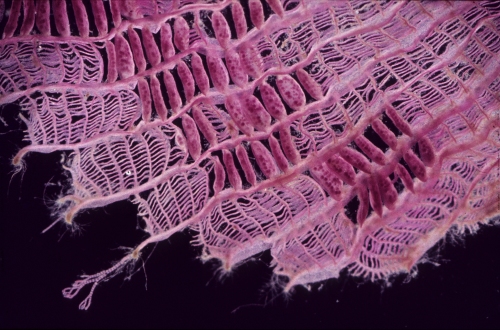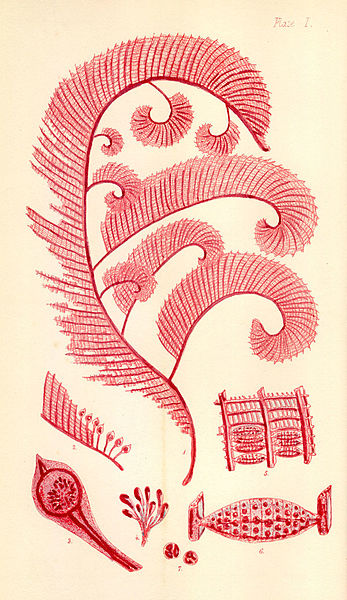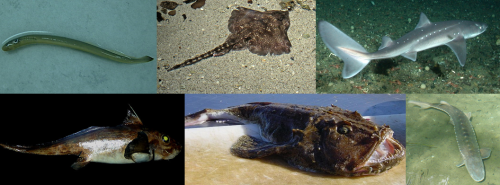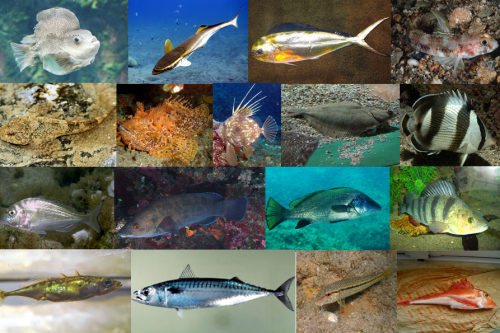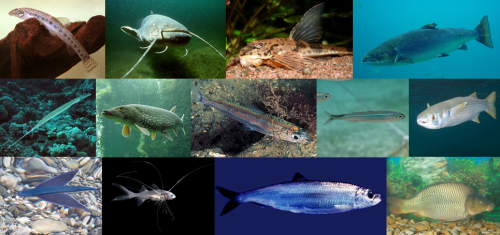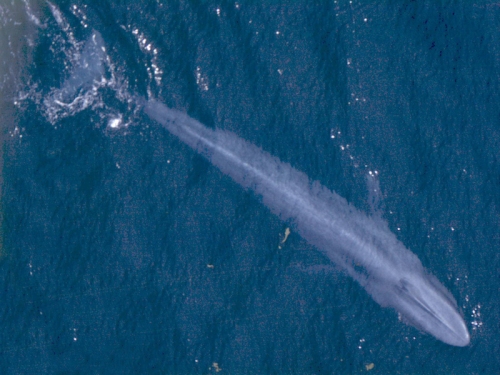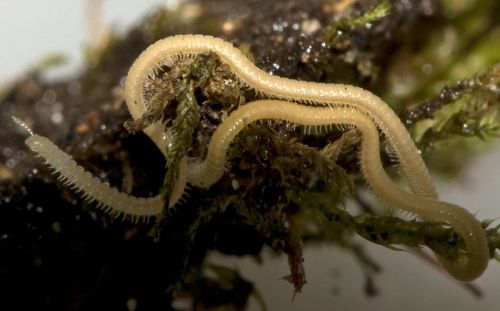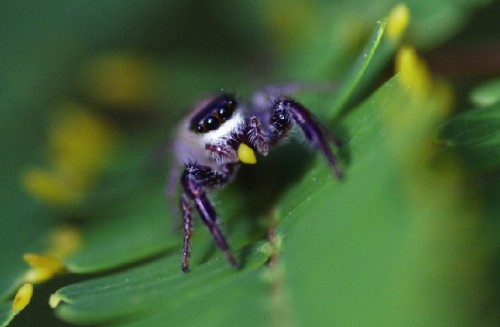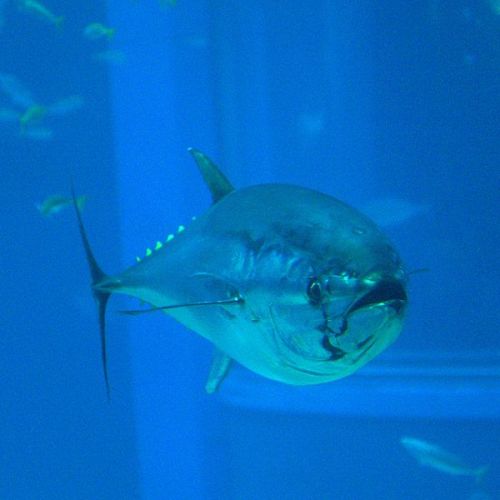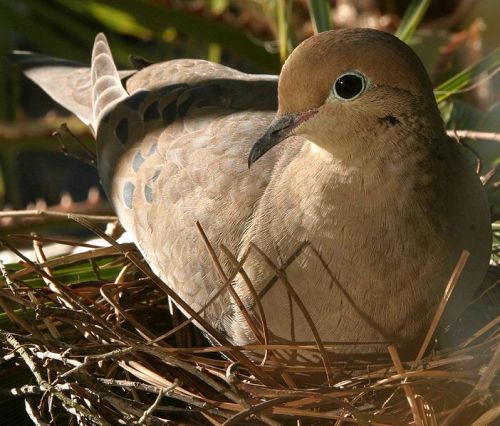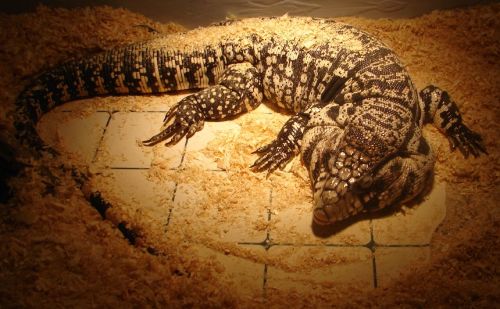by Piter Kehoma Boll
A long time ago, I wrote a post on how the classification of living beings in kingdoms have evolved since Linnaeus until the modern days. It was a brief introduction, not intended to detail it at levels below kingdom. Here, I intend to start a new series of posts where I’ll present the classification of life forms in lower levels. Each post will present a more recent classification compared to the previous one, so that you can see how things evolved through time.
So, let’s start again with Linnaeus, more precisely with the 10th Edition of his work Systema Naturae. This edition is the starting point of zoological nomenclature and was published in 1758.
In the Systema Naturae, Linnaeus divided “nature” in three kingdoms: Regnum Animale (animal kingdom), Regnum Vegetabile (vegetable kingdom) and Regnum Lapideum (mineral kingdom). As minerals are not lifeforms, we’ll not deal with it here, since this classification does not make sense at all for rocks. Maybe I’ll talk about it later in another post.
At first I would present the whole system here, but the post would become too big. Therefore, I decided to present animals and plants separately, but again there was too much to talk on animals. So, this post will deal only with mammals and birds. Other groups will be presented in subsequent posts. See amphibians and fish here, insects here and worms here.
Animals were defined by Linnaeus as having an organized, living and sentient body and being able to move freely. They were classified in six classes: Mammalia, Aves, Amphibia, Pisces, Insecta and Vermes.
1. Mammalia (Mammals)
Heart with two auricles and two ventricles; warm red blood.
Lungs breathing reciprocally.
Jaw incumbent, covered.
Penis entering in viviparous, lactating.
Senses: tongue, nostrils, touch, eyes, ears.
Covering: hairs, few for the Indic ones, fewest for the aquatic ones.
Support: four feet, except for the aquatic ones, in which the posterior feet coalesced with the tail.
Mammals included 8 orders that were defined mainly on the arrangement of teeth: Primates, Bruta, Ferae, Bestiae, Glires, Pecora, Belluae, and Cete. They are shown below with their respective genera.
1.1 Primates (prime ones), having four parallel upper incisives and solitary tusks: Homo (humans), Simia (all apes and monkeys), Lemur (lemurs), Vespertilio (bats)

Four species listed by Linnaeus under Primates (left to right): human (Homo sapiens), Barbary macaque (Simia sylvanus, now Macaca sylvanus), ring-tailed lemur (Lemur catta) and parti-colored bat (Vespertilio murinus). Credits of the photos to Pawel Ryszawa (macaque), Wikimedia Commons user Permak (lemur), and Markus Nolf (bat).
1.2 Bruta (brutes), absent incisives on either the upper or the lower jaw: Elephas (elephants), Trichechus (manatees), Bradypus (sloths), Myrmecophaga (anteaters), Manis (pangolins)

The order Bruta included (from left to right) the Asian elephant (Elephas maximus), the West Indian manatee (Trichechus manatus), the pale-throated sloth (Bradypus tridactylus), the giant anteater (Myrmecophaga tridactyla) and the Chinese pangolin (Manis pentadactyla). Credits of the photos to Wikimedia Commons user Ji-Ellle (elephant), U. S. Department of the Interior (manatee), Fernando Flores (sloth), Graham Hughes (anteater), and Wikimedia Commons user nachbarnebenan (pangolin).
1.3 Ferae (ferocious beasts) six sharp upper incisives and solitary tusks, sharp claws: Phoca (seals), Canis (dogs, foxes and hyaenas), Felis (cats), Viverra (mongooses, civets and skunks), Mustela (weasels and otters), Ursus (bears, badgers and raccoons).
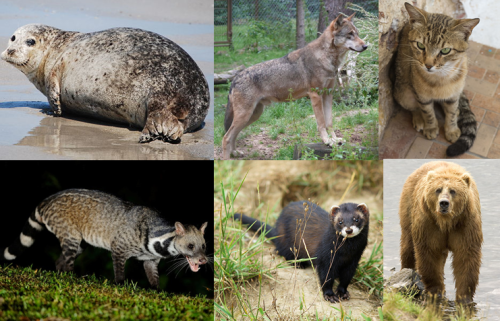
Linnaeus’ Ferae included (from left to right, top to bottom) the common seal (Phoca vitulina), the wolf (Canis lupus), the domestic cat (Felis catus, now Felis sylvestris catus), the large Indian civet (Viverra zibetha), the European polecat (Mustela putorius) and the grizzly bear (Ursus arctos). Credits to Maximilian Narr (seal), Gunnar Ries (wolf), Michal Osmenda (cat), flickr user tontravel (civet), Peter Trimming (polecat), and Steve Hillebrand (bear).
1.4 Bestiae (beasts) sharp upper teeth of indeterminate number, always more than one tusk on each side: Sus (pigs), Dasypus (armadillos), Erinaceus (hedgehogs), Talpa (moles), Sorex (shrews and moles), Didelphis (opossums)
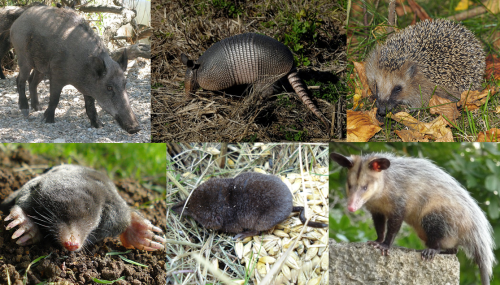
Some species in the order Bestiae (left to right, top to bottom): wild boar (Sus scrofa), nine-banded armadillo (Dasypus novemcinctus), West-European hedgehog (Erinaceus europaeus), European mole (Talpa europaea), common shrew (Sorex araneus), and common opossum (Didelphis marsupialis). Credits to Henri Bergius (boar), Hans Stieglitz (armadillo), Jörg Hempel (hedgehog), Mick E. Talbot (mole), Agnieszka Kloch (shrew), and Juan Tello (opossum).
1.5 Glires (dormice) two upper and lower incisives, no tusks: Rhinoceros (rhinoceroses), Hystrix (porcupines), Lepus (hares and rabbits), Castor (beavers and desmands), Mus (mice, rats, hamsters, marmots, etc), Sciurus (squirrels)
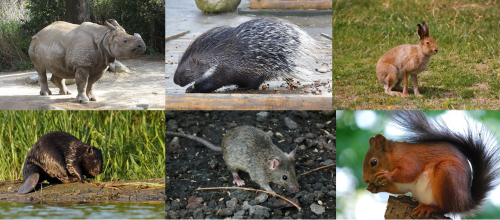
Six species that Linnaeus classified as Glires (from left to right, top to bottom): Indian rhinoceros (Rhinoceros unicornis), African crested porcupine (Hystrix cristata), mountain hare (Lepus timidus), Eurasian beaver (Castor fiber), house mouse (Mus musculus), red squirrel (Sciurus vulgaris). Credits to Wikimedia Commons user FisherQueen (rhinoceros), Wikimedia Commons user Quartl (porcupine), Alan Wolfe (hare), Klaudiusz Muchowski (beaver), Wikimedia Commons user 4028mdk09 (mouse), and Hernán de Angelis (squirrel).
1.6 Pecora (cattle) many lower incisives, no upper incisives, bifid hooves and four-chambered stomach: Camelus (camels, llamas), Moschus (musk deer), Cervus (deer and giraffes), Capra (goats and antelope), Ovis (sheep), Bos (cattle)

Among the species that Linnaeus put together as Pecora there are (from left to right, top to bottom) the dromedary camel (Camelus dromedarius), the Siberian musk deer (Moschus moschiferus), the red deer (Cervus elaphus), the domestic goat (Capra hircus, now Capra aegagrus hircus), the domestic sheep (Ovis aries) and the cattle (Bos taurus). Credits to Bjørn Christian Tørrisen (camel), F. Spangenberg (musk deer), Jörg Hempel (deer), Wolfgang Stadut (goat), Wikimedia user Jackhynes (sheep), and Andrew Butko (cattle).
1.7 Belluae (monster beasts), many obtuse incisives: Equus (horses), Hippopotamus (hippopotamuses, tapirs).
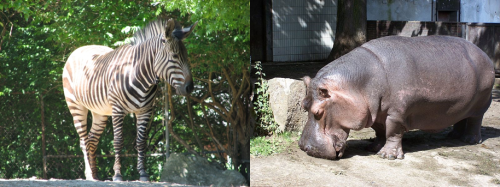
The order Belluae included the zebra (Equus zebra) and the hippopotamus (Hippopotamus amphibius). Credits to Trisha M. Shears (zebra) and Wikimedia user Irigi (hippopotamus).
1.8 Cete (sea monsters), cartilaginous teeth, aquatic animals: Monodon (narwhal), Balaena (whales), Physeter (sperm whales), and Delphinus (dolphins)

The order Cete included the following four species (left to right): narwhal (Monodon monoceros), bowhead whale (Balaena mysticetus), sperm whale (Physeter macrocephalus) and common dolphin (Delphinus delphis).
2. Aves (Birds)
Heart with two auricles and two ventricles; warm red blood.
Lungs breathing reciprocally.
Jaw incumbent, nude, extended, toothless.
Penis sub-entering, without scrotum, in oviparous, calcareous crust.
Senses: tongue, nostrils, eyes, ears without auricles.
Covering: incumbent and imbricate feathers.
Support: two feet, two wings.
Birds included 6 orders defined mainly by the shape of the bill: Accipitres, Picae, Anseres, Grallae, Gallinae, and Passeres
2.1 Accipitrae (hawks), having a curved upper jaw with a sharp end: Vultur (vultures and condors), Falco (falcons, eagles, hawks), Strix (owls), Lanius (shrikes, kingbirds, waxwings)

Accipitres included (from left to right) the Andean-condor (Vultur gryphus), the American kestrel (Falco sparverius), the tawny awl (Strix aluco) and the brown shrike (Lanius cristatus). Credits to Linda Tanner (kestrel), flickr user nottsexminer (awl), and Charles Lam (shrike).
2.2 Picae (magpies), knife-shaped bill with a convex dorsum: Psittacus (parrots), Ramphastos (toucans), Buceros (hornbills), Cuculus (cuckoos), Jynx (wrynecks), Picus (woodpeckers), Corvus (crows and ravens), Coracias (rollers and orioles), Sitta (nuthatches), Merops (bee-eaters), Trochilus (hummingbirds), Crotophaga (anis), Gracula (mynas and grackles), Paradisaea (birds-of-paradise), Alcedo (kingfishers), Upupa (hoopoes), Certhia (treecreepers).
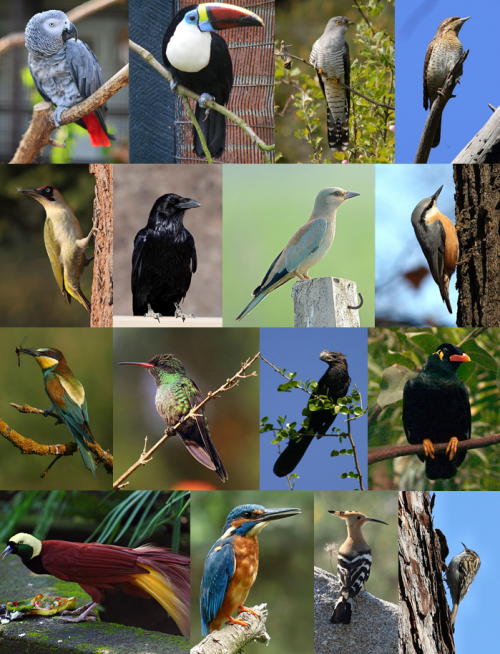
The follwing 16 species were all included in the order Picae (left to right, top to bottom): African grey parrot (Psittacus erithacus), white-throated toucan (Ramphastos tucanus), common cuckoo (Cuculus canorus), Eurasian wryneck (Jynx torquilla), green woodpecker (Picus viridis), common raven (Corvus corax), European roller (Coracias garrulus), wood nuthatch (Sitta europaea), European bee-eater (Merops apiaster), red-billed streamertail (Trochilus polytmus), smooth-billed ani (Crotophaga ani), common hill myna (Gracula religiosa), greater bird of paradise (Paradisaea apoda), common kingfisher (Alcedo atthis), Eurasian hoopoe (Upupa epops), and Eurasian treecreeper (Certhia familiaris). Credits to Wikimedia user Fiorellino (parrot), Marie Hale (toucan), Wikimedia user locaguapa (cuckoo), Carles Pastor (wryneck), Hans Jörg Hellwig (woodpecker), Alan Vermon (raven), flickr user Koshy Koshy (roller), Paweł Kuźniar (nuthatch and treecreeper), Pellinger Attila (bee-eater), Charles J. Sharp (streamertail and ani), Wikimedia user Memset (myna), Andrea Lawardi (bird-of-paradise), wikimedia user Joefrei (kingfisher), Arturo Nikolai (hoopoe).
2.3 Anseres (geese), light bill, covered with skin and with a broad end: Anas (ducks, geese and swans), Mergus (merganser), Procellaria (petrels), Diomedea (albatrosses and penguins), Pelecanus (pelicans, cormorants, gannets, boobies and frigatebirds), Phaethon (tropicbirds), Alca (auks), Colymbus (loons and grebes), Larus (gulls), Sterna (terns), Rynchops (skimmers).

Eleven species listed by Linnaeus under Anseres (left to right, top to bottom): mallard (Anas platyrhynchos), common merganser (Mergus merganser), white-chinned petrel (Procellaria aequinoctialis), wandering albatross (Diomedea exulans), great white pelican (Pelecanus onocrotalus), red-billed tropicbird (Phaethon aethereus), razorbill (Alca torda), black-throated diver (Colymbus arcticus, now Gavia arctica), common gull (Larus canus), common tern (Sterna hirundo), and black skimmer (Rynchops niger). Credits to Andreas Trepte (mallard), Dick Daniels (merganser and skimmer), Ron Knight (petrel), JJ Harrison (albatross), Nino Barbieri (pelican), Charles J Sharp (tropicbird), Steve Garvie (diver), and Arne List (gull).
2.4 Grallae (stilts), subcylindrical bill: Phoenicopterus (flamingoes), Platalea (spoonbills), Mycteria (wood stork), Tantalus (the wood stork again!), Ardea (herons, cranes and storks), Recurvirostra (avocets), Scolopax (woodcocks, ibisis, godwitts, etc), Tringa (sandpipers, lapwings and phalaropes), Fulica (coots, moorhens and jacanas), Rallus (rails), Psophia (trumpeters), Haematopus (oystercatchers), Charadrius (plovers), Otis (bustards), Struthio (ostriches, rheas, cassowaries, and dodoes).
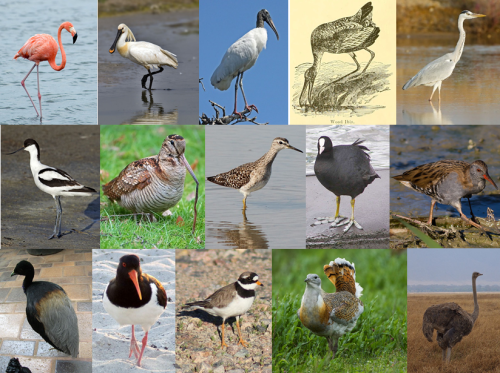
Fifteen species that Linnaeus put in the order Grallae (left to right, top to bottom): American flamingo (Phoenicopterus ruber), Eurasian spoonbill (Platalea leucorodia), wood stork (Mycteria americana), the wood stork again (Tantalus localator), grey heron (Ardea cinerea), pied avocet (Recurvirostra avosetta), Eurasian woodcock (Scolopax rusticola), wood sandpiper (Tringa glareola), Eurasian coot (Fulica atra), water rail (Rallus aquaticus), grey-winged trumpeter (Psophia crepitans), Eurasian oystercatcher (Haematopus ostralegus), ringed plover (Charadrius hiaticula), great bustard (Otis tarda), and ostrich (Struthio camelus). Credits to Paul Asman and Jill Lenoble (flamingo), Andreas Trepte (spoonbill and avocet), Dick Daniels (woodstork), JJ Harrison (heron), Ronald Slabke (woodcock), Wikimedia user Alpsdake (sandpiper), Axel Mauruszat (coot), Pierre Dalous (rail), Robin Chen (trumpeter), Wikimedia user TomCatX (oystercatcher), Wikimedia user Estormiz (plover), Francesco Varonesi (bustard), and Wikimedia user Nicor (ostrich).
2.5 Gallinae (chickens), convex bill with upper jaw bent over the lower jaw: Pavo (peafowl), Meleagris (turkeys), Crax (curassows), Phasianus (pheasants and chickens), Tetrao (grouse, partridges and quails).

Linnaeus’ Gallinae included (from left to right) the Indian peafowl (Pavo cristatus), the turkey (Meleagris gallopavo), the great curassow (Crax rubra), the common pheasant (Phasianus colchicus), and the wood grouse (Tetrao urogallus). Credits to Wikimedia user Appaloosa (peafowl), Arthur Chapman (curassow), Lukasz Lukasik (pheasant), and Wikimedia user Siga (grouse).
2.6 Passeres (sparrows), conic and acuminate bill: Columba (doves and pigeons), Alauda (larks and pipit), Turdus (thrushes, warblers and mockingbirds), Loxia (crossbills, cardinals, bullfinches, etc), Emberiza (buntings), Fringilla (finches, canaries, sparrows, tanagers, etc), Sturnus (starlings), Motacilla (wagtails, redstarts, warblers, wrens, robins, etc), Parus (tits and manakins), Hirundo (swallows and swifts), Caprimulgus (nightjars).

Eleven species considered as belonging to the order Passeres (left to right, top to bottom): wood pigeon (Columba palumbus), skylark (Alauda arvensis), blackbid (Turdus merula), red crossbil (Loxia curvirostra), yellowhammer (Emberiza citrinella), chaffinch (Fringilla coelebs), common starling (Sturnus vulgaris), white wagtail (Motacilla alba), great tit (Parus major), barn swallow (Hirundo rustica), European nightjar (Caprimulgus europaeus). Credits to Nick Fraser (pigeon), Daniel Pettersson (skylark), Andreas Eichler (blackbird), Andreas Trepte (yellowhammer), Wikimedia user Thermos (chaffinch), Pierre Selim (starling), Malene Thyssen (wagtail), flickr user chapmankj75 (tit), Martin Mecnarowski (swallow), and Dûrzan Cîrano (nightjar).
Among the most peculiar things that we can highlight here are:
- Bats were put together with the primates!
- Rhinos were put together with rodents! This happened because Linnaeus based his classification of mammals on their teeth and the front teeth of rhinos resemble somewhat those of rodents.
- Hippos and tapirs were put in the same genus! The South American tapir was called Hippopotamus terrestris!
- Giraffes were classified as deers, and badgers and raccons as bears.
- Several passerine birds, such as the kingbirds, were considered birds of prey (Accipitres).
- Albatrosses and penguins were in the same genus!
- Storks, herons and cranes were all in the same genus too.
- On the other hand, the woodstork appears twice, as two species from different genera!
As one can see, Linnaeus was not so familiar with animals. He was, afterall, a botanist, but he did his best.
– – –
Reference:
Linnaeus, Carl. 1758. Systema Naturae per Regna Tria Nature…
– – –

All images are licensed under a Creative Commons Attribution-ShareAlike 4.0 International License.
